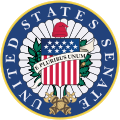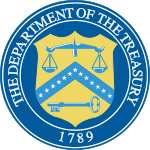Salmon P. Chase
|
Salmon Portland Chase
|
|
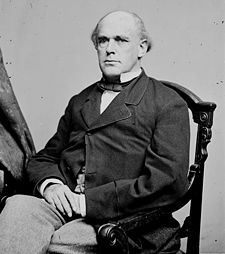 |
|
|
|
|
|---|---|
| In office December 15, 1864 – May 7, 1873 |
|
| Nominated by | Abraham Lincoln |
| Preceded by | Roger B. Taney |
| Succeeded by | Morrison R. Waite |
|
25th United States Secretary of the Treasury
|
|
| In office March 7, 1861 – June 30, 1864 |
|
| President | Abraham Lincoln |
| Preceded by | John A. Dix |
| Succeeded by | William P. Fessenden |
|
23rd Governor of Ohio
|
|
| In office January 14, 1856 – January 9, 1860 |
|
| Lieutenant | Thomas H. Ford (1856–1858) Martin Welker (1858–1860) |
| Preceded by | William Medill |
| Succeeded by | William Dennison Jr. |
|
|
|
| In office March 4, 1849 – March 3, 1855 |
|
| Preceded by | William Allen |
| Succeeded by | George E. Pugh |
| In office March 4 – March 7, 1861 |
|
| Preceded by | George E. Pugh |
| Succeeded by | John Sherman |
|
|
|
| Born | January 13, 1808 Cornish, New Hampshire, U.S. |
| Died | May 7, 1873 (aged 65) New York City, New York, U.S. |
| Political party | Free Soil, Liberty, Republican, Democrat |
| Alma mater | Cincinnati College Dartmouth College |
| Profession | Politician, Lawyer, Judge |
| Religion | Episcopalian |
Salmon Portland Chase (January 13, 1808 – May 7, 1873) was an American politician and jurist in the Civil War era who served as U.S. Senator from Ohio and Governor of Ohio; as U.S. Treasury Secretary under President Abraham Lincoln; and as Chief Justice of the United States.
Chase articulated the "Slave Power conspiracy" thesis well before Lincoln did, and he coined the slogan of the Free Soil Party, "Free Soil, Free Labor, Free Men." He devoted his enormous energies to the destruction of what he considered the Slave Power – the conspiracy of Southern slave owners to seize control of the federal government and block the progress of liberty.
Contents |
Early life and education
Chase was born in Cornish, New Hampshire to Ithmar Chase and his wife Janet Ralston. He lost his father when he was nine years old. Janet was left a widow with "a small amount of property and ten surviving children". Salmon was raised by his uncle, Philander Chase, an Episcopal bishop.[1]
He studied in the common schools of Windsor, Vermont; Worthington, Ohio; and Cincinnati College before entering the junior class at Dartmouth College, where he graduated in 1826. Although a member of the Alpha Delta Phi fraternity, he was not a member while at Dartmouth College. Chase was made a member of the Alpha Delta Phi fraternity, the third oldest continually active Greek society in the U.S. only much later in life. This was because his law partner, Samuel Eells, was the founder of the Alpha Delta Phi. While at Dartmouth he taught at the Royalton Academy in Royalton, Vermont.
Chase then moved to the District of Columbia, where he studied law under U.S. Attorney General William Wirt and continued to teach. He was admitted to the bar in 1829.
Entrance into politics
In 1830, Chase moved to Cincinnati, Ohio. Here he quickly gained a position of prominence at the bar. He published an annotated edition of the laws of Ohio which was long considered a standard. The death of his first wife in 1835 triggered Chase's spiritual reawakening and devotion to causes more aligned with his faith, including Abolitionism. He worked initially with the American Sunday School Union and began defending fugitive slaves. At a time when public opinion in Cincinnati was dominated by Southern business connections, Chase, influenced probably by James G. Birney, associated himself after 1836 with the anti-slavery movement. He became recognized as the leader of political reformers as opposed to the Garrisonian abolitionist movement.
From his defense of escaped slaves seized in Ohio under the Fugitive Slave Law of 1793, he was dubbed the Attorney General for Fugitive Slaves. His argument in the famous Jones v. Van Zandt case testing the constitutionality of fugitive slave laws before the U.S. Supreme Court attracted particular attention. In this as in other similar cases, the court ruled against him, and John Van Zandt's conviction was upheld. In brief, Chase contended that slavery was local, not national, and that it could exist only by virtue of positive state law. He argued that the federal government was not empowered by the Constitution to create slavery anywhere, and that when a slave leaves the jurisdiction of a state where slavery is legal, he ceases to be a slave, because he continues to be a man and leaves behind him the law that made him a slave.
Elected as a Whig to the Cincinnati City Council in 1840, Chase left that party the next year. For seven years he was the undisputed leader of the Liberty Party in Ohio. He helped balance the idealism of the party with his pragmatic and political thinking. He was remarkably skillful in drafting platforms and addresses, and it was he who prepared the national Liberty platform of 1843 and the Liberty address of 1845. Building the Liberty Party was slow going. By 1848 Chase was leader in the effort to combine the Liberty Party with the Barnburners or Van Buren Democrats of New York to form the Free Soil Party.
The Free Soil movement

In 1849, Chase was elected to the United States Senate from Ohio on the Free Soil Party ticket. In 1855 he was elected governor of Ohio. He drafted the famous Free-Soil platform, and it was chiefly through his influence that Van Buren was nominated for the presidency. Chase's goal, however, was not to establish a permanent new party organization, but to bring pressure to bear upon Northern Democrats to force them to adopt a policy opposed to the further extension of slavery.
During his service in the Senate (1849–1855), Chase was pre-eminently the champion of anti-slavery in that body. No one spoke more ably than he did against the Compromise Measures of 1850 and the Kansas-Nebraska Bill of 1854. The passage of the Kansas-Nebraska legislation, and the subsequent violence in Kansas, convinced Chase of the futility of trying to influence the Democrats.
He assumed the leadership in the Northwest of the movement to form a new party to oppose the extension of slavery. He attempted to unite the liberal Democrats with the dwindling Whig Party, an action that led to establishment of the Republican Party. "The Appeal of the Independent Democrats in Congress to the People of the United States", written by Chase and Giddings, and published in the New York Times of January 24, 1854, may be regarded as the earliest draft of the Republican party creed. Chase was the first Republican governor of Ohio, serving from 1855 to 1859, where he also supported women's rights, public education, and prison reform.
Chase sought the Republican nomination for president in 1860; at the Party convention, he got 49 votes on the first ballot, but was unable to gain enough support in other states. After his disappointment, he threw his support to Abraham Lincoln. With the exception of Seward, Chase was the most prominent Republican in the country and had done more against slavery than any other Republican, but he failed to secure the nomination. His views on the question of protection were not orthodox from a Republican point of view, and the old line Whig element could not forgive his previous coalition with the Democrats.
He was elected as a Republican to the U.S. Senate in 1860; took his seat March 4, 1861, but resigned two days later to become Secretary of the Treasury under Lincoln. He was member of the Peace Convention of 1861 held in Washington, D.C., in an effort to devise means to prevent the impending war.
Secretary of the Treasury

As secretary of the treasury in President Lincoln's cabinet from 1861 to 1864, during the first three years of the Civil War, he rendered services of the greatest value. That period of crisis witnessed two great changes in American financial policy, the establishment of a national banking system and the issue of a legal tender paper currency. The former was Chase's own particular measure. He suggested the idea, worked out all of the important principles and many of the details, and induced the Congress to accept them. It not only secured an immediate market for government bonds, but it also provided a permanent uniform national currency, which, though inelastic, is absolutely stable. The issue of legal tenders, the greatest financial blunder of the war, was made contrary to his wishes, although he did not, as he perhaps ought to have done, push his opposition to the point of resigning.

It should be noted, however, that the depreciating qualities of the legal tender currency were not inherent, but were placed upon them by the Senate by excepting their payment on interest of U.S. bonds, making them an inferior currency to gold. This was done in favor of the banking interests that did not favor a currency issued by the government free of interest to the banks.
The first U.S. federal currency was printed in 1862, during Chase's tenure as Secretary of the Treasury. Thus, it was his responsibility to design the notes. In an effort to further his political career, his own face appeared on a variety of U.S. paper currency. Most recently, in order to honor the man who introduced the modern system of banknotes, Chase was on the $10,000 bill, printed from 1928 to 1946. Salmon P. Chase was instrumental in placing the phrase "In God We Trust" on United States currency.[2]
Chief Justice of the United States
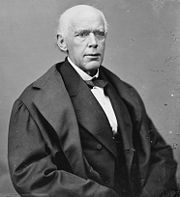
Perhaps Chase's chief defect as a statesman was an insatiable desire for supreme office.[2] Never truly accepting his defeat at the 1860 Republican National Convention, throughout his term at the Treasury department Chase repeatedly attempted to curry favor over Lincoln for another run at the Presidency in 1864. Chase had attempted to gain leverage over Lincoln three previous times by threatening resignation (which Lincoln declined largely on account of his need for Chase's work at Treasury), but with the 1864 nomination secured and the financial footing of the United States Government in solid shape, in June 1864, to Chase's great surprise, Lincoln accepted his fourth resignation offer. Partially to placate the Radical wing of the party following the resignation, however, Lincoln mentioned Chase as an able Supreme Court nominee. Several months later, upon Roger B. Taney's death in 1864, Lincoln nominated him as the Chief Justice of the United States, a position that Chase held from 1864 until his death in 1873. In striking contrast with Taney, in one of Chase's first acts as Chief Justice, Chase appointed John Rock as the first African-American attorney to argue cases before the Supreme Court.[3]

In his capacity as Chief Justice, Chase presided at the impeachment trial of President Andrew Johnson in 1868. Among his most important decisions while on the court were Texas v. White (7 Wallace, 700), 1869, in which he asserted that the Constitution provided for an indestructible union, composed of indestructible states, Veazie Bank v. Fenno (8 Wallace, 533), 1869, in defense of that part of the banking legislation of the Civil War that imposed a tax of 10 percent on state banknotes, and Hepburn v. Griswold (8 Wallace, 603), 1869, which declared certain parts of the legal tender acts to be unconstitutional. When the legal tender decision was reversed after the appointment of new judges, in 1871 and 1872 (Legal Tender Cases, 12 Wallace, 457), Chase prepared a very able dissenting opinion.
Toward the end of his life he gradually drifted back toward his old Democratic position, and made an unsuccessful effort to secure the nomination of the Democratic party for the presidency in 1868, "but was passed over because of his stance in favor of voting rights for black men."[3] He helped to found the Liberal Republican Party in 1872, unsuccessfully seeking its presidential nomination.
As early as 1868 Chase concluded that:
- "Congress was right in not limiting, by its reconstruction acts, the right of suffrage to whites; but wrong in the exclusion from suffrage of certain classes of citizens and all unable to take its prescribed retrospective oath, and wrong also in the establishment of despotic military governments for the States and in authorizing military commissions for the trial of civilians in time of peace. There should have been as little military government as possible; no military commissions; no classes excluded from suffrage; and no oath except one of faithful obedience and support to the Constitution and laws, and of sincere attachment to the constitutional Government of the United States."[4]
Death and legacy

Chase died in New York City, New York in 1873, and was interred in Oak Hill Cemetery in Washington, D.C. and later reinterred in Spring Grove Cemetery, Cincinnati, Ohio. Chase had been an active member of St. Paul Episcopal Cathedral, Cincinnati.
The Chase National Bank, a predecessor of Chase Manhattan Bank, was named in his honor, though he had no financial affiliation with it. The Manhattan Bank has as it origins as a water utility.
Chase Hall, the main barracks and dormitory at the United States Coast Guard Academy, is named for Chase in honor of his service as Secretary of the Treasury. Chase is the portrait on the $10,000 bill which was only good for settling interbank transactions. The United States Coast Guard's predecessor service, the Revenue Cutter Service, was an agency of the Department of Treasury.
Kate Chase
His daughter Katherine Chase, known as Kate, was a notable socialite, acting as her father's official hostess in Washington and unofficial campaign manager. She was known as the Civil War "Belle of Washington".[5] Her November 12, 1863, marriage to the textile magnate, Rhode Island politician William Sprague, did not flourish. After Salmon Chase's death, the Sprague marriage deteriorated further. Sprague had affairs, became alcoholic, and constantly belittled Kate's spending habits. Kate in turn reputedly had an affair with New York Senator Roscoe Conkling. The Spragues divorced in 1882. Kate Chase Sprague died in poverty in Washington, D.C. in 1899. She was buried alongside her father in Cincinnati.
See also
- United States Supreme Court cases during the Chase Court
- Origins of the American Civil War
- Places named for Salmon Chase
- Chase County, Kansas
- Institutions named for Salmon Chase
- Chase Manhattan Bank
- Salmon P. Chase College of Law in Highland Heights, Kentucky
- Salmon P. Chase Community Magnet School in Chicago, Illinois
- Appeal of the Independent Democrats
- Anti-Nebraska Party – political party
References
- ↑ Lydia Rapoza, "The Life of Salmon P. Chase, Attorney General of Fugitive Slaves 1808-1873"
- ↑ Salmon Portland Chase Encyclopedia Britannica, 1911 Edition, Originally appearing in Volume V05, Page 956
- ↑ 3.0 3.1 http://www.impeach-andrewjohnson.com/11BiographiesKeyIndividuals/SalmonPChase.htm Chase's biography at HarpWeek
- ↑ J. W. Schuckers, The Life and Public Services of Salmon Portland Chase, (1874). p. 585; letter of May 30, 1868, to August Belmont
- ↑ [1]
Secondary sources
- Blue, Frederick J. Salmon P. Chase: A Life in Politics (1987)
- Friedman, Leon. "Salmon P. Chase" in The Justices of the United States Supreme Court: Their Lives and Major Opinions. Volume 2. (1997) pp 552–67.
- Foner, Eric. Free Soil, Free Labor, Free Men: The Ideology of the Republican Party before the Civil War (1970)
- Goodwin, Doris Kearns. Team of Rivals: The Political Genius of Abraham Lincoln (2005) on Lincoln's cabinet.
- Hendrick, Burton J. Lincoln's War Cabinet (1946)
- Niven, John. Salmon P. Chase: A Biography (1995).
- Richardson, Heather Cox. The Greatest Nation of the Earth: Republican Economic Policies during the Civil War (1997)
- Salmon P. Chase at the Biographical Directory of the United States Congress
This article incorporates text from the Encyclopædia Britannica Eleventh Edition, a publication now in the public domain.
- J. W. Schuckers, The Life and Public Services of Salmon Portland Chase, (1874).
- William M. Evarts. Eulogy on Chief-Justice Chase (1874),
Salmon Chase is one of the major characters in the extensively researched historical novel "Lincoln" by Gore Vidal.
Primary sources
- Niven, John, et al eds. ed. The Salmon P. Chase Papers Volume: 2, 1823–57 (1993) vol 1–5 have coverage to 1873
- Niven, John, et al eds. ed. The Salmon P. Chase Papers Volume: 3, 1858–63 (1993)
- Donald, David ed. Inside Lincoln's Cabinet: The Civil War Diaries of Salmon P. Chase (1954)
External links
- The Life of Salmon P. Chase
- Salmon P. Chase
- Biography
- Mr. Lincoln and Freedom: Salmon P. Chase
- Eulogy on Chief-Justice Chase, delivered by William M. Evarts, 1874
| United States Senate | ||
|---|---|---|
| Preceded by William Allen |
United States Senator (Class 3) from Ohio 1849-1855 Served alongside: Thomas Corwin, Thomas Ewing, Benjamin Wade |
Succeeded by George E. Pugh |
| Preceded by George E. Pugh |
United States Senator (Class 3) from Ohio 1861 Served alongside: Benjamin Wade |
Succeeded by John Sherman |
| Political offices | ||
| Preceded by William Medill |
Governor of Ohio 1856-1860 |
Succeeded by William Dennison |
| Preceded by John Adams Dix |
United States Secretary of the Treasury 1861-1864 |
Succeeded by William P. Fessenden |
| Legal offices | ||
| Preceded by Roger B. Taney |
Chief Justice of the United States 1864-1873 |
Succeeded by Morrison Waite |
|
|||||||
|
|||||||
|
|||||||
|
|||||||
|
||||||||||||||||||||||||||||
| Supreme Court of the United States | |||||||||||||
|---|---|---|---|---|---|---|---|---|---|---|---|---|---|
|
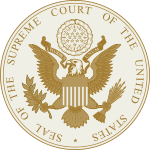 |
||||||||||||
